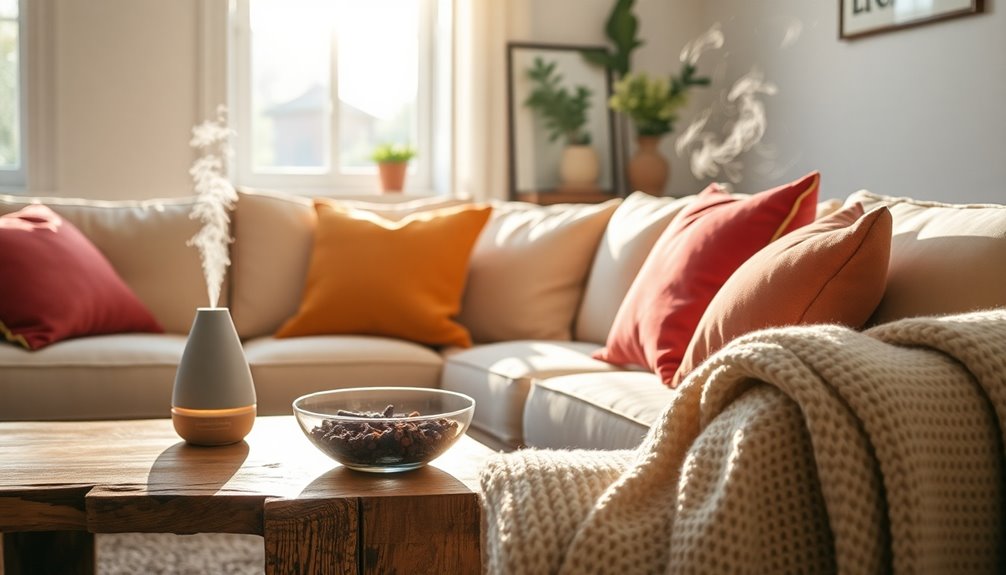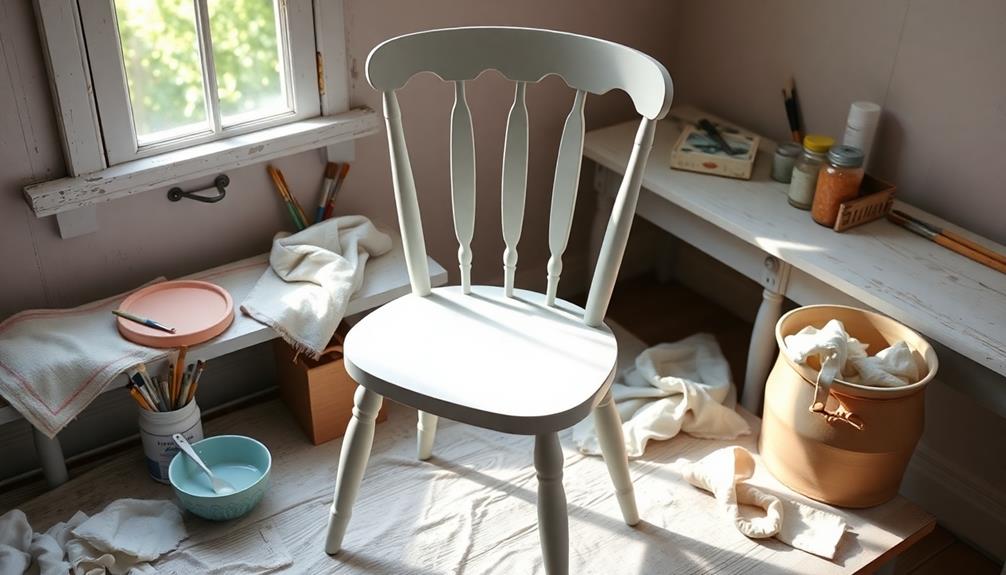To make your sofa smell good, start with regular vacuuming to remove dust and pet hair. Sprinkle baking soda on the fabric, let it sit, then vacuum to absorb odors. For an extra boost, use a fabric freshener designed for upholstery. If your sofa has removable cushions, wash them using mild detergent and vinegar to eliminate stubborn smells. You might also place scented sachets between cushions for a continuous fresh scent. Finally, consider seasonal maintenance like airing out cushions or applying protectors to keep odors at bay. There's more to explore, ensuring your sofa stays fresh and inviting.
Key Takeaways
- Regularly vacuum the sofa to remove dust, pet hair, and food particles, promoting a fresher scent.
- Apply baking soda to absorb odors, let it sit, and vacuum afterward for a clean finish.
- Use fabric fresheners designed for upholstery to effectively neutralize lingering odors.
- Wash removable cushions with mild detergent and vinegar to eliminate stubborn smells and maintain cleanliness.
- Place scented sachets between cushions for continuous freshness and to mask any unpleasant odors.
Introduction
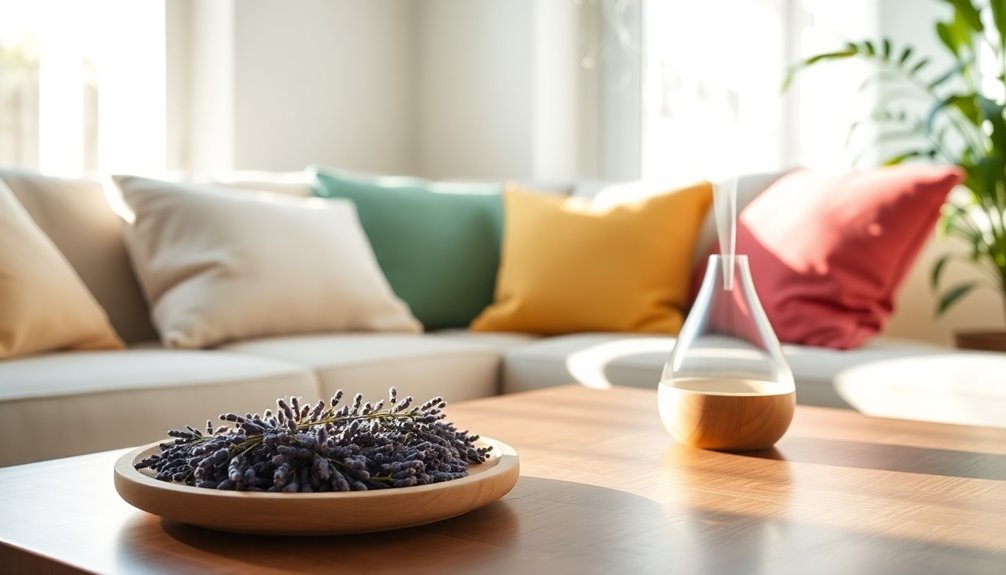
Your sofa can quickly become a magnet for odors, but with a few simple techniques, you can keep it smelling fresh. We'll explore routine fabric freshening methods, fabric-specific cleaning strategies, and how to tackle food and drink spills effectively. By following these tips, you'll enjoy a cleaner, more inviting living space.
Routine Fabric Freshening Techniques
To keep your sofa smelling fresh, incorporating routine fabric freshening techniques is essential. Start by regularly vacuuming your sofa to remove dust, pet hair, and food particles that contribute to unpleasant odors. This simple step promotes a fresher scent and prepares your fabric for deeper cleaning.
Next, sprinkle baking soda evenly across your sofa and let it sit for several hours. This will effectively absorb odors, especially pet smells, and vacuuming afterward ensures a clean finish. For an extra boost, use fabric fresheners or odor-eliminating sprays designed for upholstery. These products can help neutralize odors and provide a pleasant scent.
Don't forget about those removable cushions! Washing them periodically with mild detergent and a bit of vinegar can help eliminate stubborn odors and maintain overall cleanliness. Additionally, consider placing scented sachets or dryer sheets between cushions for continuous freshness, effectively masking any lingering odors. By following these routine fabric freshening techniques, your sofa will not only smell good but also feel inviting and comfortable for you and your guests. Regular vacuuming can also improve your sofa's longevity by reducing wear and tear on the fabric, ensuring it stays in good condition longer.
Fabric-Specific Cleaning Techniques
When it comes to maintaining a fresh-smelling sofa, understanding the specific cleaning techniques for different fabrics is key. Each fabric type has its own cleaning method, so you'll want to check the manufacturer's instructions before diving in. For example, if your couch cushions have a "W" label, you can safely use water-based cleaners, but stick to solvent cleaners for "S" labeled fabrics.
If you have delicate fabrics, opt for gentle cleaning methods. A damp cloth or an upholstery attachment on your vacuum can work wonders without risking damage. Leather, on the other hand, requires special care; use leather conditioners and avoid soaking it with water or vinegar to prevent cracking.
Regularly rotating your couch cushions not only promotes even wear but also helps maintain fabric freshness by exposing different areas to air and cleaning. This practice is particularly useful for eliminating pet odors, as it allows you to treat each section effectively. By tailoring your cleaning approach to the fabric type, you'll keep your sofa smelling great while ensuring its longevity.
Targeting Food and Drink Spills
Spills from food and drinks can quickly turn your once-fresh sofa into a source of unpleasant odors. To tackle food and drink spills effectively, it's crucial to act fast. Blot spills immediately with a clean cloth to absorb excess liquid; rubbing can spread the stain and stubborn smells. If you're dealing with solid food particles, gently scrape off any residue using a dull knife or spoon before you clean the area.
To clean and deodorize the affected spot, mix a small amount of mild dish soap with water. Dampen a cloth with this solution and gently apply it to the stained area. After cleaning, make sure to rinse the spot with a damp cloth to remove any soap residue, which could attract dirt if left behind.
Don't forget to regularly inspect your sofa for hidden areas where spills may lurk, especially in crevices and under cushions. Catching these hidden spills early can help you avoid persistent odors and keep your sofa smelling fresh. Additionally, regular cleaning can enhance the effectiveness of your home's air quality systems, ensuring that your living space remains pleasant and healthy. With a little attention, you can maintain a pleasant atmosphere in your living space!
Sofa Shielding Techniques
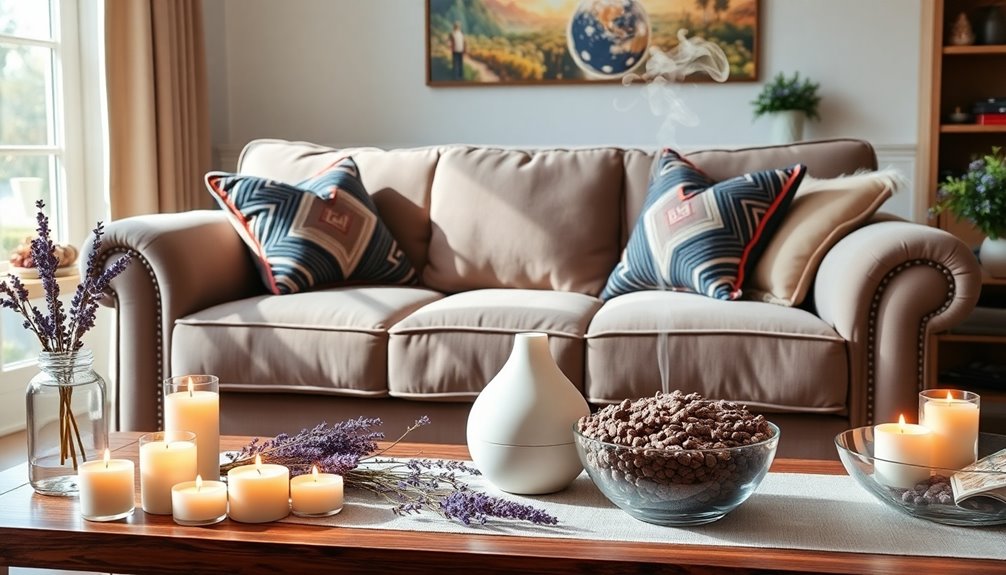
When it comes to keeping your sofa smelling fresh, choosing pet-resistant upholstery is a smart move that can save you from future headaches. You might also want to explore decorative fabric protectors that not only look great but also shield against odors. Plus, minimizing fabric friction can help maintain your sofa's integrity while reducing the chances of unwanted smells.
Pet-Resistant Upholstery Choices
To keep your sofa smelling fresh in a pet-friendly home, it's essential to choose upholstery that resists odors and stains. Start by selecting tightly woven fabrics, like microfiber or synthetic blends, as they're less likely to absorb pet odors and are easier to clean. These materials provide a strong barrier against spills and messes.
Consider upholstery treated with stain-resistant coatings, which repel pet-related accidents, making maintenance a breeze. Pet-friendly materials, such as leather or faux leather, are also fantastic options because they can be wiped clean and don't trap dander or odors as easily as traditional fabrics do.
When shopping, opt for sofas with removable and washable cushion covers. This feature allows you to regularly clean and combat odors, keeping your seating area fresh. Additionally, select designs with minimal seams and crevices, which help reduce hidden spaces where pet hair and odors can accumulate. By making these thoughtful choices, you can create a cozy, inviting space that remains pleasant and clean, despite your furry friends.
Decorative Fabric Protectors
Choosing the right upholstery is just the beginning of keeping your sofa looking and smelling great. Decorative fabric protectors, like slipcovers or fabric sprays, play a crucial role in maintaining your sofa's freshness. These protectors shield your furniture from spills, stains, and odors, allowing you to enjoy a clean appearance. Many fabric protectors feature water-resistant properties, so you can easily wipe away accidental spills before they set in.
By utilizing decorative fabric protectors, you're not only preventing dirt and grime from embedding into the fibers but also making regular cleaning a breeze. Some products even come with odor-neutralizing agents, which help keep your sofa smelling fresh, especially in homes with pets or kids. Additionally, consider the benefits of air purifier maintenance to further enhance your home's air quality and reduce lingering odors in your living space.
To maximize their effectiveness, be sure to apply fabric protectors every few months. This regular application will enhance their protective qualities, ensuring your sofa stays free from wear and unpleasant odors. With these strategies in place, you'll maintain a comfortable, inviting space that you and your guests will love. So, don't overlook the importance of decorative fabric protectors in your sofa care routine!
Minimizing Fabric Friction
Minimizing fabric friction is essential for maintaining your sofa's appearance and scent. Start by using couch covers or throws to shield your fabric from wear and tear, which can trap odors and retain moisture over time. Opt for slipcovers that are machine washable, making cleaning easier without causing excessive friction on the fabric.
Consider applying a fabric protector spray to create a barrier against spills and stains, reducing the need for frequent deep cleaning. This protective layer helps you keep your sofa looking fresh and minimizes fabric friction that can lead to wear.
Regularly fluff and rotate your cushions to prevent uneven wear and maintain airflow, which can help mitigate trapped odors. Implementing a no-shoes policy on the couch is another effective strategy; it minimizes dirt and oil transfer from footwear, thus reducing fabric friction and odor buildup. Additionally, keeping your sofa clean can help prevent acute kidney failure in pets who might be sensitive to lingering odors from food or other sources.
Couch Frame Stability Checks

When you check your couch frame for stability, start by examining the joints for any signs of damage. Ensuring the integrity of these frame joints is crucial for comfort and longevity. Once you've assessed the frame, consider how leather conditioning and upholstery rejuvenation can enhance both the look and feel of your couch.
Frame Joint Integrity Checks
Maintaining a sturdy couch frame is essential for both comfort and longevity, so make frame joint integrity checks a regular part of your furniture upkeep. Start by inspecting the joints of the couch frame for any signs of loosening or creaking. These indicators can signal a need for tightening or reinforcement. Use a level to ensure the couch sits evenly; an unstable frame can lead to discomfort and affect the upholstery's lifespan.
When performing integrity checks, pay special attention to the corner blocks and dowels. These components are critical for the overall stability of your couch. If your frame is wooden, look for cracks or splits, which can compromise both strength and safety.
An effective solution for reinforcing weak joints is applying wood glue or using brackets. This will help ensure a sturdy frame that can withstand regular use without wobbling or shifting. By keeping up with frame joint integrity checks, you not only maintain your couch's stability but also create a more pleasant environment, reducing the likelihood of common household issues like pet smells. After all, a well-maintained couch is a great foundation for an odor eliminator to work seamlessly!
Leather Conditioning Treatments
Leather conditioning treatments are essential for preserving the beauty and longevity of your leather couch. To keep your leather in top shape, use a leather conditioner every 6 to 12 months. This routine helps prevent drying and cracking, which can lead to unpleasant odors and deterioration of the material. Make sure to choose a conditioner specifically designed for your type of leather, as different finishes require unique care approaches.
Before applying the leather conditioner, it's a good idea to check your couch frame's stability. A sturdy frame ensures that your couch can support weight without creaking or wobbling, enhancing comfort. After conditioning, allow the leather to breathe by placing it in a well-ventilated area. Avoid direct sunlight, as it can cause fading and further damage.
To maintain your couch's condition between treatments, frequently dust and gently clean with a damp cloth. This practice prevents the buildup of dirt and grime, which can contribute to unpleasant odors. By following these steps, you'll keep your leather couch looking and smelling great for years to come.
Upholstery Rejuvenation Techniques
Regularly checking your couch frame is crucial for ensuring its stability and comfort. Start by inspecting for any signs of weakness, like squeaking sounds or uneven legs. If you find loose screws or bolts, tighten them immediately to prevent shifting and extend the sofa's lifespan. This also helps reduce areas where odors can accumulate, particularly pet smells.
Next, check for wood rot or damage in wooden frames. Any deterioration can lead to unpleasant odors and compromise the structural integrity of your couch. Ensure that all joints and connections are secure; loose frames can cause fabric to stretch, trapping musty smells within the upholstery.
To further enhance air circulation and minimize moisture buildup, consider using furniture coasters to elevate your couch off the floor. This simple step can significantly reduce the chances of musty odors developing.
After performing these checks, you might want to sprinkle some baking soda on the upholstery for added freshness. Let it sit for a few hours, then vacuum it up to remove the baking soda. This upholstery rejuvenation technique not only improves stability but also keeps your couch smelling great.
Custom Fabric Treatments

When it comes to keeping your sofa smelling fresh and looking great, custom fabric treatments are a game-changer. These treatments often involve applying a fabric protector that repels stains and odors, helping to extend the life and freshness of your upholstery. You can also explore specialized fabric sprays that contain odor-neutralizing agents designed to penetrate the fibers and eliminate those persistent smells.
If you want an extra touch, consider custom scenting options that infuse pleasant fragrances into your fabric during the treatment process. This not only enhances the ambiance of your space but also ensures your sofa remains inviting. Professional fabric treatments frequently include steam cleaning using customized solutions, allowing for deep cleaning and deodorization without damaging the material.
Seasonal Fabric Maintenance Tips
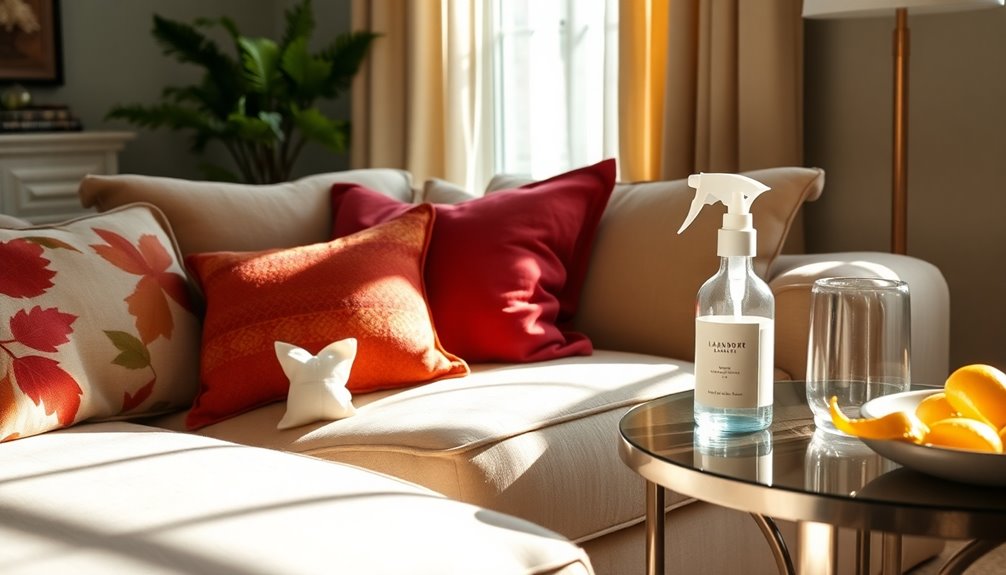
Transform your sofa's upkeep by embracing seasonal fabric maintenance tips that keep it smelling fresh and looking its best. In spring, dive into deep cleaning; vacuum thoroughly, steam clean, and refresh your cushions to eliminate winter odors and allergens.
As summer rolls in, take advantage of sunny days by airing out your cushions outside. The sunlight works wonders to remove pet smells and freshen your fabric. In fall, consider using protective covers to shield your sofa from dust and pet hair, as indoor heating can intensify odors.
During winter, it's crucial to fluff and rotate your cushions regularly. This helps prevent moisture buildup and traps odors from heating systems that can dry out your fabrics.
Throughout the year, don't forget to incorporate seasonal scents into your cleaning routine. A few drops of cinnamon or pine essential oils in your cleaning solutions or a nearby diffuser can make your couch smell delightful. For a quick fix, you can also sprinkle baking soda on your cushions and vacuum it up after a few hours to absorb unwanted smells. Embrace these tips to keep your sofa fresh for every season!
Conclusion

Maintaining a fresh-smelling sofa is simpler than you might think, and it doesn't take much effort to achieve great results. By focusing on regular cleaning and maintenance, you can prevent odors from taking hold. Vacuuming your sofa and spot cleaning spills promptly, especially if they involve pet urine, will keep your smelly couch at bay.
Utilizing natural deodorizing methods, like baking soda, is an effective way to neutralize odors without resorting to harsh chemicals. Just sprinkle baking soda on your cushions, let it sit for a while, and then vacuum it up for a fresher scent. Additionally, airing out your cushions in sunlight and fresh air can work wonders in dissipating trapped odors.
Incorporating fabric fresheners or scented sachets can also add a pleasant fragrance to your sofa. Don’t forget that consistent attention to spills and debris is crucial, particularly in homes with pets. By following these simple steps, you’ll maintain a sofa that not only looks good but smells great too. So, embrace these easy techniques, and enjoy a fresh, inviting living space! Additionally, consider mixing sofa and loveseat styles to create a more personalized and dynamic living area. This combination not only adds visual interest but also allows you to play with different textures and colors, enhancing the overall ambiance of your space. Remember, a well-maintained sofa, paired with thoughtful design choices, will ensure your living room remains a welcoming retreat for both family and guests alike.
Frequently Asked Questions
How Can I Make My Sofa Smell Fresh?
To make your sofa smell fresh, start by sprinkling baking soda generously on it and letting it sit for a few hours. After that, vacuum it up. You can also mix equal parts distilled white vinegar and water in a spray bottle, lightly mist the sofa, and let it dry. For an extra boost, place your sofa outside on a sunny day or tuck scented sachets under the cushions for lasting freshness.
How Do I Stop My Couch From Smelling Like Sick?
To stop your couch from smelling like sick, you need to act quickly. First, vacuum it thoroughly to remove any debris. Sprinkle baking soda over the entire surface and let it sit for a few hours to absorb odors. Clean any stains immediately with a damp cloth and mild detergent. Consider using an enzymatic cleaner for tough smells. Finally, air it out in a well-ventilated space to help freshen it up.
Why Does My Couch Smell Funky?
Your couch might smell funky due to accumulated food particles, pet dander, or moisture trapped in the upholstery. If you've had spills or your pets frequent the couch, those odors can seep into the fabric and linger. Bacteria and mold thrive in such environments, contributing to the unpleasant smell. Regular maintenance and cleaning are essential to keep it fresh and prevent the buildup of these odor-causing elements.
How Long to Leave Baking Soda on a Smelly Couch?
You should leave baking soda on a smelly couch for at least 15 to 30 minutes for optimal odor absorption. If the smells are deeper, consider letting it sit overnight for better results. Many people recommend allowing it to remain for 6 to 12 hours to fully neutralize odors. Afterward, vacuum thoroughly to remove both the baking soda and the absorbed odors, ensuring your couch is fresh and clean.
